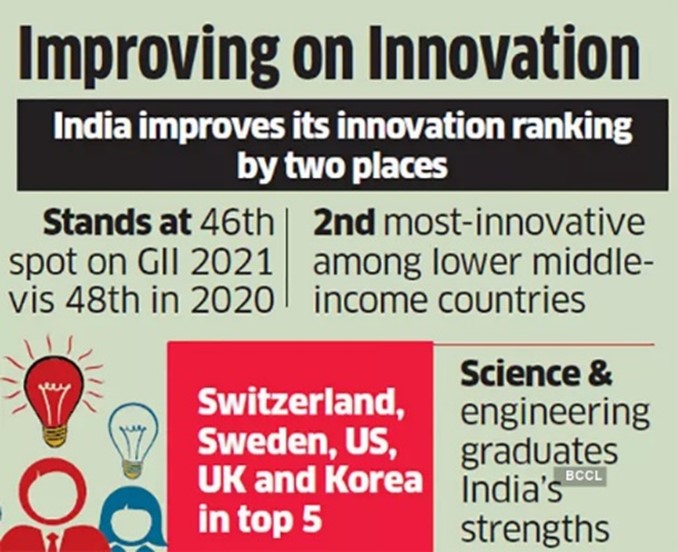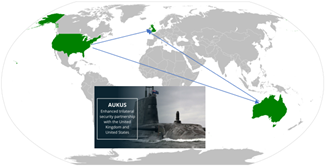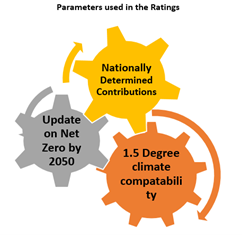Thursday, 23rd September 2021
Updated Air Quality Guidelines by WHO
In News
The World Health Organization (WHO) released their revised Air Quality Guidelines after a gap of 16 years.
About the news
- New World Health Organization (WHO) Global Air Quality Guidelines (AQGs) provide clear evidence of the damage air pollution inflicts on human health, at even lower concentrations than previously understood.
- The guidelines recommend new air quality levels to protect the health of populations, by reducing levels of key air pollutants, some of which also contribute to climate change.
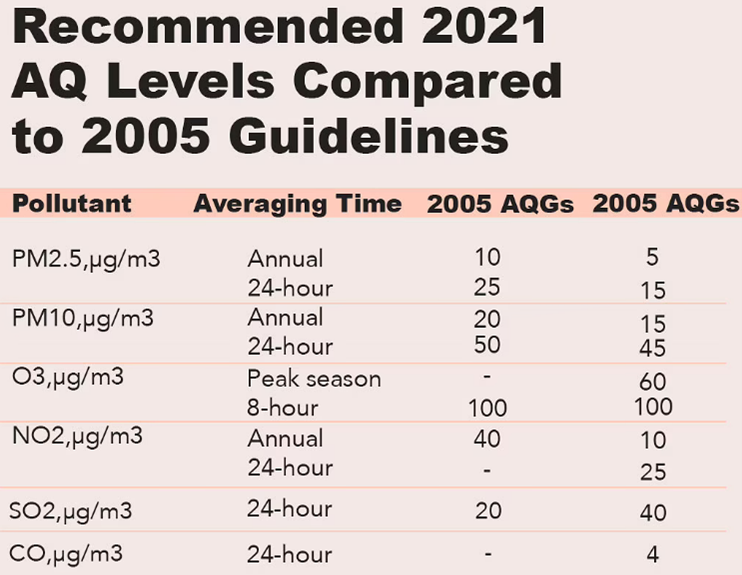
- The guidelines also highlight good practices for the management of certain types of particulate matter (for example, black carbon/elemental carbon, ultrafine particles, particles originating from sand and dust storms) for which there is currently insufficient quantitative evidence to set air quality guideline levels. They are applicable to both outdoor and indoor environments globally, and cover all settings.
- The recommended annual standard of PM2.5 concentration has been decreased from 10 µg/m3 to 5 µg/m3, while the daily standard has dipped from 25 µg/m3 to 15 µg/m3, suggesting a stricter monitoring of air pollution levels across the globe.
- They are not legally binding but serve as a base for the governments across the world to set their own standards.
Health Impacts of Air Pollution
- The burden of disease attributable to air pollution is on a par with other major health risks such as unhealthy diet and tobacco smoking.
- Every year, exposure to air pollution is estimated to cause 7 million premature deaths.
- In adults, ischaemic heart disease and stroke are the most common causes of premature death attributable to outdoor air pollution.
- In children, this could include reduced lung growth and function, respiratory infections and aggravated asthma.
Air Pollution and India
- According to the World Air Quality Report, 2020 by IQAir, 22 out of top 30 most polluted cities are from India.
- The National Ambient Air Quality Standards (NAAQS), set in 2009 are more relaxed compared to the 2005 WHO guidelines.
- National Clean Air Programme (NCAP) is being implemented to reduce 20-30% of PM2.5 and PM10 concentrations recorded in 2017 by 2024.
Sources:
Global food systems need change: IFAD
In News
United Nations International Fund for Agricultural Development (IFAD) has released its report “Transforming Food Systems for Rural Prosperity “.
Findings of the Report
- Transformation of World’s food systems: The report called for revolutionary transformation of the world’s present food systems as they have failed to make nutritious diets accessible or affordable to the poor and in a sustainable way. It has led to growing malnutrition, increased food waste and a high environmental cost.
- Need for Investment in rural farms: Government investment in rural farms and local small- and medium-size enterprises is needed which support activities after the farm gate, such as storing, processing, marketing and food distribution.
- Role of Small-scale family farmers: They are the foundation of food supply across all low- and middle-income countries and play a critical role in reducing rural poverty and ensuring national food and nutrition security.
- Farms of up to two hectares produce 31 per cent of the world’s food on less than 11 per cent of the farmland.
- Accessibility of food markets: Need to make food markets accessible to villagers by rethinking the present concentration of power within food systems.
- Contributor to Climate Change and vulnerable to it: Food systems are responsible for 37 per cent of greenhouse gas emissions and are also highly vulnerable to a changing climate.
Recommendations of the Report
- Rewarding farmers for ecosystem services such as maintaining healthy soil and regulating pests and incentives for nature-based practices and local, healthy diet.
- Making available innovations such as nature-based solutions, agro-ecology and affordable digital technologies to boost rural small-scale famers’ production. These measures will also enable the cultivators to be climate-resilient employing low-carbon and sustainable techniques
- Developing and focusing on pricing systems that reflect the full and true cost of production.
- Shifting food systems towards circular resource use for sustainability and resilience

Source:
Growth in the Exports of Software Services: RBI Survey
In News
The RBI has released data related to the 2020-21 round of its annual survey on exports of computer software and information technology enabled services.
Findings of the Report
- Software Exports: India's exports of software services (excluding exports through commercial presence) are estimated at $133.7 billion during 2020-21, recording a 4.0% growth over the previous year.
- Exports by Foreign Affiliates: Software exports by foreign affiliates through commercial presence, where the US is a major destination stood at $14.6 billion in 2020-21.
- Total exports: Total exports of software services, including services delivered by foreign affiliates of Indian companies, recorded 2.1% growth during 2020-21 and stood at $148.3 billion.
- Share of Private companies: Over half of the exports of software services were made by private limited companies.
- Major Destinations: The US was the major destination for software exports accounting for 54.8%; Europe accounted for 30.1% half of which was in the UK.
- Invoicing currencies: The US dollar has been the principal invoicing currency for software exports with 72% share; euro and pound sterling together has accounted for another 15.9%.
International trade in services by mode of supply
General Agreement of Trade in Services (GATS) has been an important driving force in the establishment of a classification of four different modes of trade in services.
- Mode 1: Cross-border supply: This takes place when a service is supplied “from the territory of one Member into the territory of any other Member”. This is comparable to trade in goods where the product is delivered across borders and the consumer and the supplier remain in their respective territories.
- The RBI noted that the share of mode-1 (cross-border supply) in India's exports of software services has increased further to 78.4% in 2020-21.
- Mode 2: This takes place when the service is supplied “in the territory of one Member to the service consumer of any other Member”, i.e. either the consumer or his property is abroad.
- Mode 3: “Commercial presence” takes place through “the supply of a service by a service supplier of one Member, through commercial presence in the territory of any other Member”.
- Mode 4: “Temporary presence of natural persons” takes place when an individual is temporarily present in the territory of an economy other than their own to provide a commercial service.
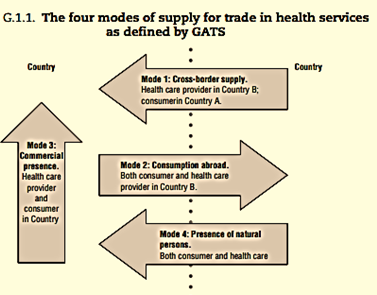
Sources:
- Exports of software services up 2.1% to $148.3 billion in 2020-21: RBI survey
- International Standards and Classifications of Trade and Tourism
Image Source:
Discontinuation of the Ease of Doing Business Report
In News
Recently, the World Bank decided to discontinue the Ease of Doing Business report which publishes the annual ranking of countries on the Ease of Doing Business (EDB) index.
About the News
- After data irregularities on Doing Business 2018 and 2020 were reported internally in June 2020, World Bank management paused the next Doing Business report and initiated a series of reviews and audits of the report and its methodology.
- In addition, because the internal reports raised ethical matters, including the conduct of former Board officials as well as current and/or former Bank staff, management reported the allegations to the Bank’s appropriate internal accountability mechanisms.
- An independent scrutiny by leading US law firm WilmerHale showed that China's massive data manipulation to hide slippage in the World Bank Group's Ease of Doing Business (EODB) rankings.
- These revelations come in the backdrop of concerns on China’s pressure tactics with WHO on the origins of the coronavirus and reporting the initial spread, its growing influence at the WTO and increasing control over key UN bodies.
- Similar protests arose when the Doing Business 2020 report was fudged under political pressure to change the rankings of Saudi Arabia, the United Arab Emirates (UAE) and Azerbaijan.
About the Doing Business Report
- In 2002, the World Bank introduced the report, whose annual rankings highlight which countries have adopted policies favourable to businesses and which haven't - and how much they're improving or regressing.
- The quantitative indicators of the report ranged from dealing with construction permits, getting electricity, getting credit, protecting minority investors, paying taxes, and trading across borders. These could be compared across 190 economies and over time.
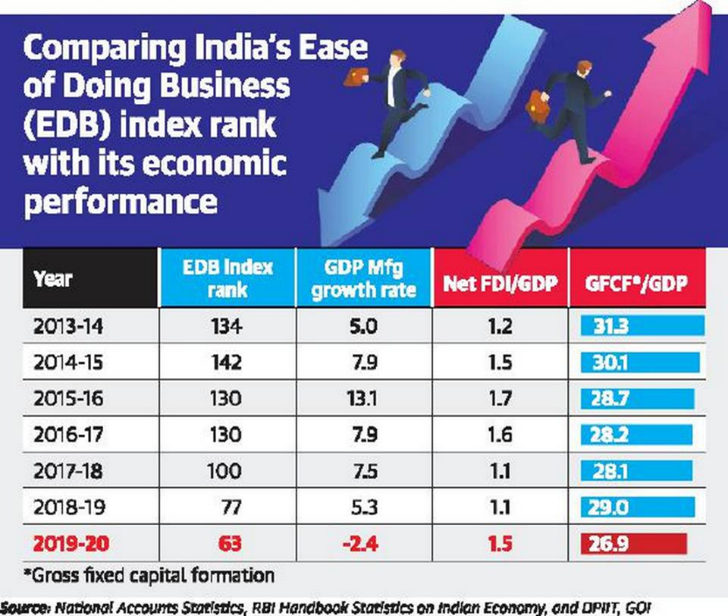
How much Significance did the findings and ranking of the Report hold for the countries?
- Policy making for countries: National leaders often set EDB rank targets. This helps them measure domestic policies against global “best practices” and browbeat domestic critics.
- Sometimes, nations would pursue substantive policy changes. India, for instance, wanted its administration to ensure that India breaks into the top 50 ranks of the EDB index.
- Influence on Investments: Investors use the World Bank's "Doing Business" report to help decide where to invest money, open manufacturing plants or sell products. Eager to attract investment, countries have sought to improve their rankings in the World Bank's report.
- The growing significance of the index was partially due to rising interest across the developing countries which are continuously engaged in seeking more foreign direct investment.
How does the EDB matter to India?
- India’s Performance and Reforms: India zoomed to the 63rd position in 2019-20. Showcasing the accomplishment, India has claimed success of the ‘Make in India’ campaign. India was also placed in the list of “economies with the most notable improvement” for the third year in a row
- The government has focused on improving India’s rankings. It also initiated reforms to improve conditions of doing business on the ground across local, state and national levels.
- Impact of this incident on India: India hopes the massive fraud highlighted in the audit report of Doing Business ranking by the World Bank, which pointed out undue pressure from China to improve its ranking, will help shift manufacturing supply chains to India.
But, despite the high significance of the EDB report, it has its share of flaws
- Faulty measurement and Data: The theory underlying the EDB index could be suspect, the measurement and data could be faulty, or both. Measuring regulatory functions underlying the index could be tricky and subjective and possibly politically motivated.
- Even decent data could be interpreted in dramatically different As a famous economic saying goes, 'If you torture the data enough, they will confess to anything.'
- Vulnerable to Political Influences: Politics definitely matters in international organisations. The US has the clout to appoint every World Bank president, and the EU every IMF chief. All efforts to democratise the process have failed. At lower levels, every important donor and recipient can influence outcomes.
- Doubt on Indicators: The first Doing Business report in 2004 covered 12 indicators of the ease of doing business in different countries. It proved a hit with member governments, which wanted international benchmarks to promote their own reforms and boast of achievements. The statistical infirmities were, however, immediately highlighted by economists.
- Problematic Data Collection: Data collection was problematic. Data were initially gathered from only one city, later expanded to two. But this did not represent the whole country. Despite economists pointing out technical flaws, the political pressure to continue persuaded the Bank to carry on.
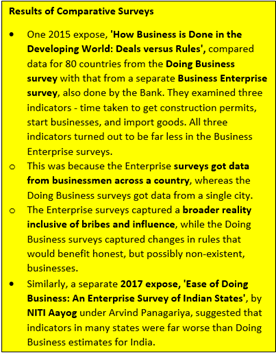
What can be the Learnings from this episode for other international organizations?
- Indicator of growing clout: The probe into the manipulation of China’s ranking in the 2018 doing business report indicates the hold of China on multilateral institutions. International institutions are needed to provide clear rules for economic activity more than ever, but their legitimacy is under threat. The World Bank, the International Monetary Fund, and the World Trade Organization face stress from nationalistic policies.
- Need for Real Indicators: The obsession with ratings and rankings results in our celebrating ‘improvements’ without quite understanding the methodology or impact of such rankings on the larger goals affecting the lives of a larger group of stakeholders.
- Ratings and rankings, in general, promote a certain homogeneous paradigm of success, one which may not be in line with the specific needs of individual countries or even institutions.
Way Forward
- The Doing Business reports may be abandoned, but governments will seek a replacement, and maybe look to other indices devised by international think-tanks and other organisations.
- Perfect data and perfectly impartial interpretation do not practically exist. Consider an indicator as basic as gross national product (GNP). Economists and politicians have wailed for decades that it can be grossly misleading, ignoring dimensions of development and well-being.
- Alternative indices like human development to gender equality were developed. But all of them suffer from data problems and from political pressures too.
- Problematic data and indices are better than none. We must seek to expose problems and improve data collection and interpretation. But, the competition between states and between countries, however imperfect, can help improve the performance of countries in dozens of ways. That is reason enough to persist.
Question: Discuss the problems with the Doing Business report. What does the discontinuation of this indicate about the problems in International organizations?
Sources:
- View: Despite the World Bank controversy, flawed data and indices are better than none
- Explainer: Why World Bank is under fire over set of rankings
- World Bank fiasco reveals China's ease of doing business with multilateral institutions
- China manipulated Ease of Doing Business rankings, no irregularities found in Indian data
- Explained | The World Bank controversy that killed the Doing Business Report
- India sees opportunity as World Bank audit finds China fraud
- The World Bank scandal is a bad sign for the future of globalization
- The doing-better syndrome and our prisoner’s dilemma
- Why the World Bank Torched its ‘Ease of Doing Business’ Ranking
- The end of the doing business rankings
This day in history - Battle of Assaye
On September 23, 1803, The British East India Company defeated the Maratha army at the Battle of Assaye. This battle was so fierce that though Wellesley went on to defeat and exile Napoleon Bonaparte at Waterloo later in his life and career, he would insist that the battle of Assaye – where the 34-year-old Wellesley commanded an army against the Maratha Empire – was the one that he considered to be his finest achievement, and one of the most closely fought. 23 September every year since 1803 is celebrated as Assaye Day by the 74th Highlanders (later amalgamated to become The Highland Light Infantry) and The 78th Highlanders (later The Seaforth Highlanders) who were awarded the Assaye Colour by the East India Company. Battle of Assaye also paved the way for British domination of central India, and eventually the entire subcontinent.

Source:
Image of the day - Cheraman Juma Masjid
This is image of the Cheraman Juma Masjid. The classic beauty and humble style of the "Cheraman Juma Masjid", dating back to 629 AD, was restored after a painstaking renovation and conservation process spread over nearly 30 months under the state-run Muziris Heritage Project (MHP). It is located at Kodungallur taluk in this central Kerala district. The Cheraman Masjid occupies a pivotal place in the Muziris civilisation that enjoyed glory as the ancient world’s greatest trading centre in the East, trading everything from spices to precious stones. The land, also known as Mahodayapuram or Muyirikkode, was the capital of the Perumals as rulers in the line of Chera kings between 9th and 12th centuries AD.

Source:
Ellora caves
- Context: Rain water seeping into Cave number 32 at the Ellora has damaged some paintings.
- It is a UNESCO World Heritage site and it comprises of 34 monasteries and temples excavated side by side in the wall of a high basalt cliff in the Charanandari hills.
- There are 17 Hindu caves, 12 Buddhist and 5 Jain caves with deities, carvings and even monasteries depicting the mythology of each religion which denotes its spirit of tolerance, harmony and solidarity among all faiths and beliefs.
- Cave 32, known as ‘Indra Sabha’ is a two storey architectural marvel excavated in the ninth century and considered as the largest and the finest of the Jain caves at the Ellora
- Dating back from the 6th to 10th century, the Ellora caves lie in the Sahyadri hills of Maharashtra.
- The inscriptions on the walls of the Ellora Caves date back to the 6th century-famous ones include:
- Rashtrakuta Dantidurga on the mandapa of Cave 15.
- Cave 16 or Kailasha temple - a monument dedicated to Shiva is the largest single monolithic rock excavated in the world built during 757-783 AD by Krishna I.
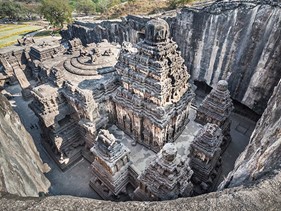
Sources:
Image Source:
Input tax credit
- Context: Since October ’19, the government has cut tax credits available to businesses where vendors fail to upload details.
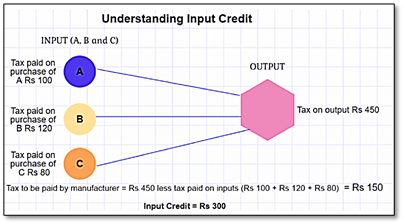
- Input credit means at the time of paying tax on output, one can reduce the tax he/she has already paid on inputs and pay the balance amount.
- When we buy a product/service from a registered dealer, we pay taxes on the purchase and on selling it we collect the tax.
- We adjust the taxes paid at the time of purchase with the amount of output tax (tax on sales) and balance liability of tax (tax on sales minus tax on purchase) has to be paid to the government. This mechanism is called utilization of input tax credit.
- For example- you are a manufacturer:
- Tax payable on output (FINAL PRODUCT) is Rs 450
- Tax paid on input (PURCHASES) is Rs 300
- You can claim INPUT CREDIT of Rs 300 and have to deposit Rs 150 in taxes.
Sources:
Hilsa Fish
- Context: Bangladesh government has permitted the export of over 2,000 tonnes of hilsa fish to Bengal ahead of Durga Puja.
- The Hilsa (Tenualosa ilisha) is an anadromous fish (those that spend most of their lives in the sea but migrate to fresh water to spawn).
- Hilsa Fish is often tagged as the Queen of Fish for its taste and the Bangladeshi Hilsa, found in River Padma, is considered to be tastier than the ones found in Ganga.
- Every year during the monsoon, shoals of Hilsa swim several kilometres from the sea into the estuaries and upstream along the rivers for spawning after which they return to the Bay of Bengal.
- The eggs hatch in freshwater and the sub-adult Hilsa swim downstream into the sea.
- The fish weigh between 700 and 1200 grams each and the cost is around ₹900 – ₹1,500 per kilo.
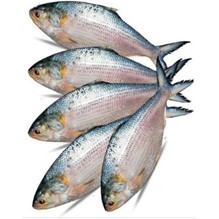
Sources:
- Bangladesh to export over 2,000 tonnes Padma hilsa as Durga Puja gift
- Bangladesh to send 2,000 tonnes of Hilsa fish ahead of Durga Puja
Image Source:
New curriculum for schools
- Context: The Government up a committee headed by K Kasturirangan, to revise the NCERT textbooks.
- The document, known as the National Curriculum Framework (NCF), is a guiding document for the development of textbooks, syllabi and teaching practices in schools across the country.
- It was last prepared in 2005 and was previously revised in 1975, 1988 and 2000.
- The new NCF will be drafted as per the perspectives of the National Education Policy (NEP).
- The committee will also develop curriculum for early childhood, teacher and adult education.
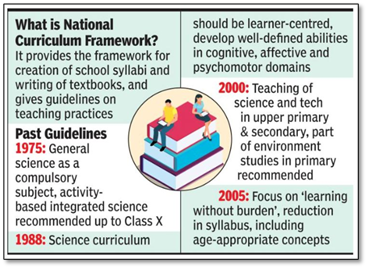
Sources:
Image Source
Need for reform in Judicial appointments
Essence: In this article, the author makes a case for reforming the existing system of judicial appointments, particularly to the High Courts.
Routine opaque transfers and appointments without any independent scrutiny gives de facto extraconstitutional power of administrative superintendence to the Supreme Court over the High Courts. This reduces the importance of the High Courts.
The editorial explains the evolution of procedure of appointment of judges and insists on the importance of finding a middle ground between the need for judicial independence and transparency in procedures so that public interest is well served.
Why should you read this article?
- To understand the importance of transparent appointment process to judiciary.
- To appreciate the need for a balance between judicial independence and the need for transparency.
Source:
A flawed calculation of inflation
Essence: There has been a trend of rising inflation in the country. The article tries to highlight various issues related to calculation of wholesale price index and the consumer price index. The data fails to represent the actual scenario because of the change in the consumption pattern during the lockdown. Also, the consumption pattern varied with poor, the middle classes, and the rich class as some sectors of economy and society were hit badly by the lockdown. A change in consumption pattern was also observed as many services were not used during the lockdown like travel and hotel.
To conclude the current official inflation rate does not correctly measure price rise since the lockdown administered a shock to the economy. The method of calculation certainly needs revision.
Why you should read this article?
- To understand the changes in the consumption pattern during lockdown.
- Why do we need revision in the method of calculation of data?
Source:
Why Modi’s visit to the US matters
Essence: Indian Prime Minister visiting USA in his first foreign tour in six months has pressing issues to discuss with global leaders including the President of United States. The editorial elaborates on the issues that concern India currently ranging from America’s withdrawal from Afghanistan and signing of the AUKUS defence pact which excludes India. These issues have given India much to worry about its foreign policy choices. India will be looking to strengthen QUAD and other growing coalition of nations with a shared interest in seeking a secure and stable Indo Pacific region.
Why should you read this article?
- To understand foreign policy challenges before India.
- To know about recent developments in Indo pacific.
Source:
Human Library: Denmark
Background
- Lack of Empathy: The fast-moving self-centered world provides less time for one to interact with others.
About Menneskebiblioteket
- Human Library: became a new trend around the world just after its launch in Denmark.
- Participation: Humans can either volunteer to be a book or a reader.
- Time: Time allotted to converse is 30 min per book.
- Genre: books entitled “Alcoholic,” “Bipolar,” “Depression,” and “Convert”

Change Maker
- Positivity: open conversations challenge the stereotypes and prejudices through dialogue.
- Portability: Portable library that can operate with a group as well.
- Oration: The oration leads a lasting impression of the book in the mind of the reader.
- Breaking the barriers: Use of socially unacceptable questions to break from the parochial mindset.
Presence in India
Human Libraries are also found in Delhi, Hyderabad, Indore, and Chennai.
Source:
Image Source:
Share the article
Get Latest Updates on Offers, Event dates, and free Mentorship sessions.

Get in touch with our Expert Academic Counsellors 👋
FAQs
UPSC Daily Current Affairs focuses on learning current events on a daily basis. An aspirant needs to study regular and updated information about current events, news, and relevant topics that are important for UPSC aspirants. It covers national and international affairs, government policies, socio-economic issues, science and technology advancements, and more.
UPSC Daily Current Affairs provides aspirants with a concise and comprehensive overview of the latest happenings and developments across various fields. It helps aspirants stay updated with current affairs and provides them with valuable insights and analysis, which are essential for answering questions in the UPSC examinations. It enhances their knowledge, analytical skills, and ability to connect current affairs with the UPSC syllabus.
UPSC Daily Current Affairs covers a wide range of topics, including politics, economics, science and technology, environment, social issues, governance, international relations, and more. It offers news summaries, in-depth analyses, editorials, opinion pieces, and relevant study materials. It also provides practice questions and quizzes to help aspirants test their understanding of current affairs.
Edukemy's UPSC Daily Current Affairs can be accessed through:
- UPSC Daily Current Affairs can be accessed through Current Affairs tab at the top of the Main Page of Edukemy.
- Edukemy Mobile app: The Daily Current Affairs can also be access through Edukemy Mobile App.
- Social media: Follow Edukemy’s official social media accounts or pages that provide UPSC Daily Current Affairs updates, including Facebook, Twitter, or Telegram channels.


